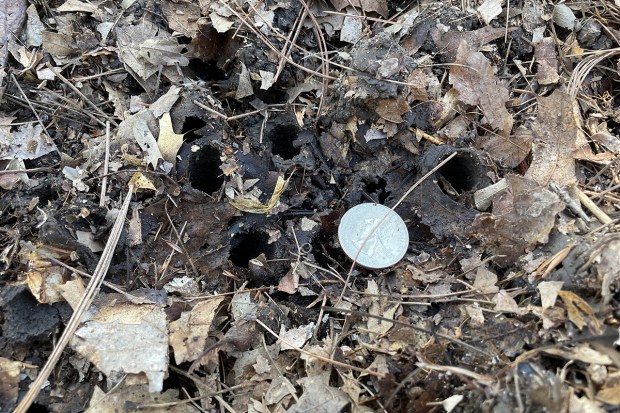There’s been a lot of buzz about the unusual emergence of two broods of cicadas in one year, a phenomenon already under way in southern parts of the country and soon be happening in Illinois.
Brood XIX makes its appearance every 13 years and hasn’t been seen since 2011. Brood XIII only emerges every 17 years and has been buried underground since 2007. The last time they both showed up at the same time was 1803.
So, yes, there will be a lot of the critters around to make noise this summer, but not necessarily in this area so no need to fear an apocalyptic event here, experts say.
“While there will be billions of cicadas emerging across the country, there won’t be three-inch piles of them,” said Jamie Viebach, horticulture educator for the University of Illinois Extension in Naperville.
Viebach’s been trying to cut down on all the clamor over the impending “invasion” by giving talks to local groups across DuPage, Kane and Kendall counties to dispel the anxiety it’s causing for some and to urge people to “look on the cool side” of witnessing a rare natural occurrence.
We posed some questions to Viebach about cicadas in general and what’s happening this year. This is what she had to say. (Some answers have been edited for space.)
When might we start to see the cicadas emerge in our area?
Cicadas come out when the soil temperatures reach about 64 degrees eight inches below sod. (As of Friday afternoon, soil temperature at that level was 59.6, according to the data station in St. Charles.)
Grubs are close to the surface. You might uncover a few if you’re digging around trees or shrubs right now, but they won’t come out to molt and start singing (screaming) until it warms up a bit. I’m estimating that it will be around the second week of May.
Will the Elgin area see both broods that are set to reemerge?
No. This is one of the biggest misconceptions right now.
This year is special because there is a 13-year brood and a 17-year brood both coming out at the same time. The 13-year brood is in southern Illinois while the 17-year brood is in northern Illinois.
There will likely be a small area of overlap, but it will be way south of here. There are different estimates of where that overlap will occur, but given that an overlap like this hasn’t happened in 221 years, no one is 100% sure where it will be.
It’s possible it will be around Champaign, Springfield or Bloomington, but at most it will be maybe in three counties.
Where will the cicadas be most prevalent?
Basically, anywhere there are older trees and the ground hasn’t been disturbed. Cicada nymphs, or grubs, live underground for most of their lives, using their straw-like mouthparts to drink sap from tree roots.
Since they don’t move very far — a half mile in their lifetime and mostly above ground — if something happens to the tree they’re snacking on, they’ll starve unless there are roots from adjacent trees very close.
If the soil is scraped off because of construction, they’ll die. Basically, they have to be somewhere nothing is going to bother the soil for 17 years. It’s no wonder most of them die before they reach adulthood.
So, if you live in a newer subdivision that isn’t near a forest preserve or are surrounded by farm fields, you probably won’t see very many. But if you’re in an area with a lot of old trees, you could see quite a few.
What will be their impact on the local environment?
Female cicadas lay their eggs in the smaller, newer branches of trees. In older, more mature trees, it might end up being like a natural form of pruning and won’t hurt the tree at all. Some studies have shown improved health, like the tree producing more apples or more flowers the following year.
If the tree or shrub is newly planted or very small — think the “whips” handed out to kids at Earth Day events — there could be a substantial amount of damage that the tree cannot recover from. In those cases, we recommend covering the tree or shrub with a fine netting, like tulle fabric, or insect netting that has no wider than quarter-inch openings.
Their emergence holes, some of which we’re already seeing, will aerate the soil and their decaying bodies will provide some fertilizer to plants.
Are there really zombie cicadas?
Yes. There is a fungus that can take over their central nervous system, like cordyceps in ants, or like what happened in the show, “The Last of Us.” The fungus drives them to mate, which then infects the unsuspecting mate.
Nature is brutal like that sometimes.
Do cicadas have an impact be on other wildlife?
They are low fat and have a protein content similar to beef so chances are wildlife won’t be getting fat on them. We may see healthier nestlings and an uptick in foraging behavior. That is, raccoons, skunks and opossum may be digging slightly more in your flower beds.
FIsh eat them, too. My husband fishes. He told me that fly tiers are making lures that look like cicadas.

Is it OK for pets and people to eat them?
I’m not a vet, but generally, in a healthy dog or cat, eating a few won’t cause any harm. If they eat too many cicadas, they might get a tummy ache. Generally, it’s just an extra bit of protein.
For people, if you’re allergic to shellfish, you should not eat them as you can have a similar reaction.
Additionally, they are thought to potentially accumulate mercury and could have some pesticide residues if they’re used around the area they are in. So proceed with caution if you’re going to eat them.
So, people should just let them be to live out their short lives?
Exactly. In adult form, they’ll live about four to six weeks. They’re not toxic. They don’t bite or sting. They basically have no form of self-defense, other than being really, really loud. Pesticides won’t have any impact on them, so the university does not recommend using any kind of chemicals on them.
How loud will they get?
They’ve been measured to 100 decibels, which is as loud as a lawn mower.
Mike Danahey is a freelance reporter for The Courier-News.




